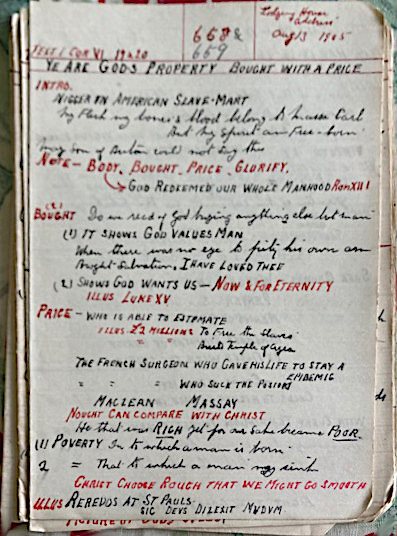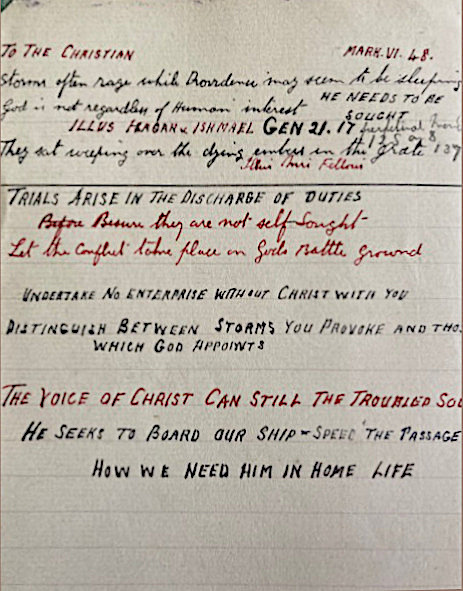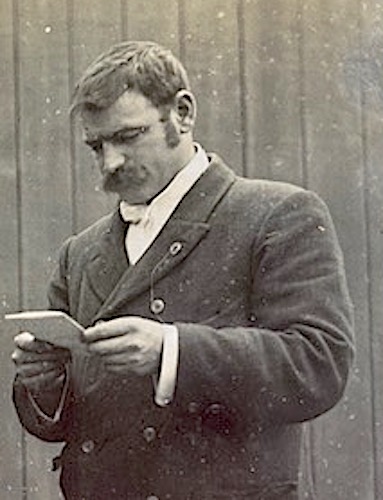Images kindly provided by Helen Hughes, great-granddaughter of David Smith. They have all been slightly adjusted for better clarity. They may be used without prior permission for any scholarly or educational purpose as long as you (1) credit Helen Hughes and (2) link your document to this URL in a web document or cite the Victorian Web in a print one. Click on all the images to enlarge them.

Labelled: "Aged 30 1896 The year D.S.
came into the N. Mission.
In the last decade of the nineteenth century, when David Smith started his missionary work among the navvies, this kind of outreach was already well established. In the mid-1870s, the Rev. Daniel Barrett, Vicar of Nassington, had been convinced of the need for it: "the very nature of the exigencies of railway, reservoir, dock and such like works, the shifting character of the population, the brevity of its stay in one place, the almost incessant shoals of workmen passing up and down" made it impossible, he realised "to build up a settled and permanent congregation." Yet, he felt, "infinite good may be done by the efforts of the Church in the midst of such a population.... wherever the Church goes with her message of love and mercy, if that message is delivered with strong faith and persistent zeal, men will be gathered in, and souls won for the Master. It was in the strength of this faith that our work was begun and carried out" (88).
Nassington, where the Rev. Barrett was Vicar, is in Northamptonshire, on the Peterborough and Northampton railway line. The Bishop of Peterborough himself was a prime mover in setting up missions in the area. Irish himself, William Connor Magee (1821-1891), was perhaps concerned about the strong Irish element among the navvies, and decided to put Barrett in charge of their spiritual welfare. This was in an important initiative by the established church, and it set a precedent. Efforts were finally co-ordinated when the Navvy Mission Society was founded in November 1877, through the determination of another clergyman, the Rev. Lewis Moule Evans (1846–1878) in Yorkshire, and the exertions of "the Navvies' friend," Elizabeth Garnett (1839-1921). The tireless Garnett described how the new society flourished: "God has blessed us and supplied our needs, and therefore, with one of the smallest incomes of any religious society, we have, socially, morally, and spiritually, been able to do four times the usual amount of work. We spend nothing on offices, clerks, advertising, etc. Every penny given goes to the work" (100). Having started to work with the mission in 1896, Navvy Smith's own proselytising and teaching activities took place among the navvies engaged in some of the most challenging engineering projects of the day, including, early on in his involvement with them, the Sodbury Tunnel under the Cotswolds, which is over four miles long.
Examples of Navvy Smith's Sermons




From left to right. (a) "The Promised Definite Experience." (b) "The Consideration of Christ for Others." (c) Ye are God's Property Bought with a Price." (d) "To the Christian."
Remarkably, Navvy Smith's sermon notes have been preserved by his family. These notes, using different inks, capital letters and handwriting to show different levels of importance, are impressively succinct and well-organised. The subjects are useful and focussed, with suitable examples from the Bible and everyday life. One phrase leaps out in the "Promised Definite Experience," where Navvy Smith talks to the navvies in Shirehampton on 10 June 1905: "Absence of Foggy Theology." Something in the nature of "a note to self," this seems to have been his personal rule. Under the last heading in this sermon, "Discipline," he has jotted down: "Workshop below Residence above," suggesting that he planned to talk about earthly experience, and the entry to Heaven, in terms the navvies would easily have understood. Terry Coleman talks of the "naīve sort of preaching" that the navvies would have heard (183), but Navvy Smith knew his audience and pitched his sermons well.

Navvies, in general, had a reputation for heavy drinking, scrapping, and other kinds of anti-social behaviour. Catherine March (1818-1912), who had much earlier done sterling work with the navvies in Kent and London, particularly amongst those involved with erecting the Crystal Palace, noted how feared they were by the communities through which they passed: "This inroad of strangers was justly dreaded by the steady parishioners, for these men with truth called themselves 'a rough lot,' and a navvy was looked upon as an Ishmaelite, 'his hand against every man, and every man's hand against him'" (106). Navvy Smith's sermon notes for 20 May 1905, headed "The Consideration of Christ for Others," had obvious relevance here, recommending "Proper Thought for Others," while the next set of notes, for 13 August 1905, is headed "We are God's Property," and seeks to remind the navvies that "God values man," in this way trying to instil in them a new spirit of self-worth.
The last example shown above, on the far right, is a page of notes for a sermon entitled "To the Christian." Navvy Smith acknowledges that life is hard — but asks the men to distinguish between "trials" that are "self-sought" and those that are not, and to "Let the conflict take place on God's battle ground," in other words, the soul. The navvies were not known for living in harmony at home, any more than outside it: the last heading for this sermon is "How we need Him in home life."
In such ways, with a balance of subtlety and straight talking, Navvy Smith worked hard on several fronts — to develop the navvies' faith, and implant in them a new reliance on God; to improve their image in their own minds; and to help them live in accordance with social norms. Preaching and pastoral care went hand in hand for him.
Links to Related Material
- Navvy Smith's Photograph Albums, 1: Navvies at Work
- Navvy Smith's Photograph Albums, 2: Activities of the Navvy Mission
- Churching the Ungodly
- The Victorian Navvy
- Victorian Navvies — Their Nationality, Religion, Social Position, and Relation to the Armed Services
Bibliography and Further Reading
Barrett, D. W. Life and Work among the Navvies. 2nd ed. London: Wells Gardner, Darton & Co., 1888. Internet Archive. From a copy in the Bodleian, Oxford University. Web. 14 August 2023.
Coleman, Terry. The Railway Navvies: A History of the Men who Made the Railway. London: Pimlico, 2000.
Garnett, Mrs Charles. "How and Why the Navvy Mission Society was Formed." Woman's Mission. Ed. Angela Burdett-Coutts. New York: Scribner's, 1893. 92-105. Internet Archive. From a copy in the University of California Libraries. Web. 14 August 2023.
Marsh, Catherine. "My Work among Navvies at Beckenham." Woman's Mission. Ed. Angela Burdett-Coutts. New York: Scribner's, 1893. 106-10. Internet Archive. From a copy in the University of California Libraries. Web. 14 August 2023.
Sullivan, Dick. Navvyman. Coracle, 1983. [full text on this website.
Created 14 August 2023